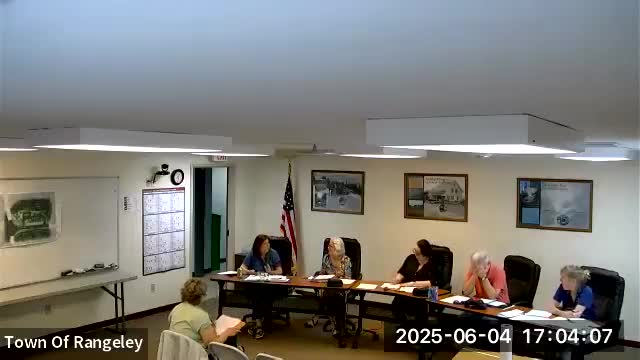Town Council debates changes to LED lighting ordinance amid community concerns
June 04, 2025 | Rangeley, Franklin County , Maine
This article was created by AI summarizing key points discussed. AI makes mistakes, so for full details and context, please refer to the video of the full meeting. Please report any errors so we can fix them. Report an error »

In the heart of Rangeley, Maine, a recent meeting of the Ordinance Committee sparked a lively discussion about the implications of new lighting regulations aimed at promoting energy efficiency and preserving dark skies. As committee members gathered around the table, the conversation quickly turned to the complexities of transitioning from traditional incandescent bulbs to modern LED lighting.
One member expressed confusion over the brightness of LED bulbs compared to their incandescent counterparts, highlighting the challenge of making clear comparisons for residents unfamiliar with the technicalities. “The whole purpose of an LED bulb is you get more lumens for less wattage,” they noted, emphasizing the energy efficiency that LEDs offer. However, the lack of industry standards for LED brightness made it difficult to provide straightforward comparisons, leaving some committee members pondering how best to inform the public.
The discussion then shifted to the proposed ordinance language, which aimed to regulate both new and existing lighting. Some committee members voiced concerns about the retrofitting requirements, arguing that mandating changes to existing fixtures could be seen as micromanaging residents' lives. “I understand new and retrofit, but I’m not comfortable with trying to go backwards,” one member stated, reflecting a sentiment shared by others who felt that existing installations should not be forced to comply with new regulations.
Legal implications also surfaced during the meeting, as members questioned whether the town had the authority to enforce changes on existing lighting. The consensus seemed to be that while new regulations could be applied moving forward, retroactive enforcement could lead to legal complications. “Generally speaking, any newly adopted ordinances are in effect from the date of adoption forward,” one member clarified, reinforcing the idea that existing fixtures should remain untouched unless voluntarily updated.
As the meeting progressed, the committee recognized the need for clear communication with the public. Suggestions were made to create informational materials that could visually demonstrate the differences in lighting options, helping residents make informed decisions without feeling overwhelmed by technical jargon.
In conclusion, the Ordinance Committee's meeting underscored the delicate balance between promoting energy efficiency and respecting the established choices of residents. As Rangeley navigates the complexities of modern lighting regulations, the committee remains committed to ensuring that any changes are both practical and considerate of the community's needs. The path forward may be fraught with challenges, but the dialogue continues, reflecting a community engaged in thoughtful decision-making for a brighter, more sustainable future.
One member expressed confusion over the brightness of LED bulbs compared to their incandescent counterparts, highlighting the challenge of making clear comparisons for residents unfamiliar with the technicalities. “The whole purpose of an LED bulb is you get more lumens for less wattage,” they noted, emphasizing the energy efficiency that LEDs offer. However, the lack of industry standards for LED brightness made it difficult to provide straightforward comparisons, leaving some committee members pondering how best to inform the public.
The discussion then shifted to the proposed ordinance language, which aimed to regulate both new and existing lighting. Some committee members voiced concerns about the retrofitting requirements, arguing that mandating changes to existing fixtures could be seen as micromanaging residents' lives. “I understand new and retrofit, but I’m not comfortable with trying to go backwards,” one member stated, reflecting a sentiment shared by others who felt that existing installations should not be forced to comply with new regulations.
Legal implications also surfaced during the meeting, as members questioned whether the town had the authority to enforce changes on existing lighting. The consensus seemed to be that while new regulations could be applied moving forward, retroactive enforcement could lead to legal complications. “Generally speaking, any newly adopted ordinances are in effect from the date of adoption forward,” one member clarified, reinforcing the idea that existing fixtures should remain untouched unless voluntarily updated.
As the meeting progressed, the committee recognized the need for clear communication with the public. Suggestions were made to create informational materials that could visually demonstrate the differences in lighting options, helping residents make informed decisions without feeling overwhelmed by technical jargon.
In conclusion, the Ordinance Committee's meeting underscored the delicate balance between promoting energy efficiency and respecting the established choices of residents. As Rangeley navigates the complexities of modern lighting regulations, the committee remains committed to ensuring that any changes are both practical and considerate of the community's needs. The path forward may be fraught with challenges, but the dialogue continues, reflecting a community engaged in thoughtful decision-making for a brighter, more sustainable future.
View full meeting
This article is based on a recent meeting—watch the full video and explore the complete transcript for deeper insights into the discussion.
View full meeting
